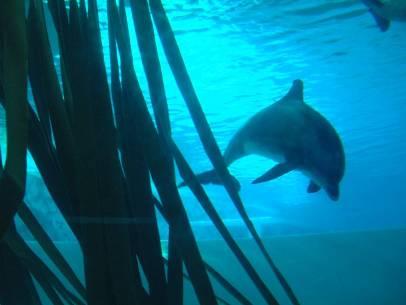
Conclusion
A concrete pool constitutes an acoustically poor environment for a dolphin. The using of toys made of acoustically transparent materials such as rubber, plastic and fabric leaves the open water column acoustically empty. If toys are floating the water column stays also visually empty. This leaves the dolphins with a barren habitat far from the richness of the sea.
Odontocetes use active sonar as one of their main sources of information (Gordon & Tyack 2002). The sonar system of dolphins is highly advanced with a well developed cognitive processing, which takes up a large part of the brain activity (Ridgway 1990, 2000). For the welfare of dolphins in human care it is important to find ways to encourage and stimulate sonar use.
The general sonar activity measured with passive porpoise detectors (POD’s) in the Kolmården dolphin colony was surprisingly low and almost no sonar emissions were recorded during night hours when the dolphins were most likely resting. An increased sonar activity was seen in the morning hours before the trainers arrived.
The artificial kelp stimulated some sonar activity but it increased even further when the kelp was supplemented with a number of net-floats with high sonar target strength.
Objects with good sonar target strength, such as the POD’s and the net-floats in the kelp, appeared to be used by the dolphins as acoustic land marks in otherwise acoustically empty surroundings.
The interactive hose device encouraged intense sonar use as well as roused general interest. The moving hose tip triggered prey chasing behavior with which sonar is associated.
The dolphins responded positively to all the tested acoustic enrichment additions, which should encourage further exploration of this kind of enrichment.
Recommendations
When designing pool facilities, the possibilities for dolphins to use their sonar should be of high consideration. This includes pool shape, wall and floor materials, structures in the water column and interchangeable objects. Appropriate enrichment devices and structures can be developed and implemented in existing traditional pools to improve the acoustic properties of the environment.
Submerged obstacles, objects limiting the visibility, and moving objects can be added to pools in order to challenge the dolphins and provide a changing and stimulating environment. Objects offering a good and acoustically interesting sonar echo can be further added to the environment as can devices constructed for the open water column. In this way the habitat created will be closer to resembling a natural coastal area.
The positive response to objects used as acoustical key references or land marks in this study motivates the adding of objects with high sonar target strength in open or acoustically empty areas.
As seen in this study the interactive device seemed to be a very positive addition. Other acoustically interactive concepts can be explored, e.g. ways for the dolphins to interact acoustically with trainers or visitors. Even if live fish cannot be offered, opportunities to perform hunting behavior should be and can be provided.
Responsible for this page:
Director of undergraduate studies Biology
Last updated:
09/06/05
